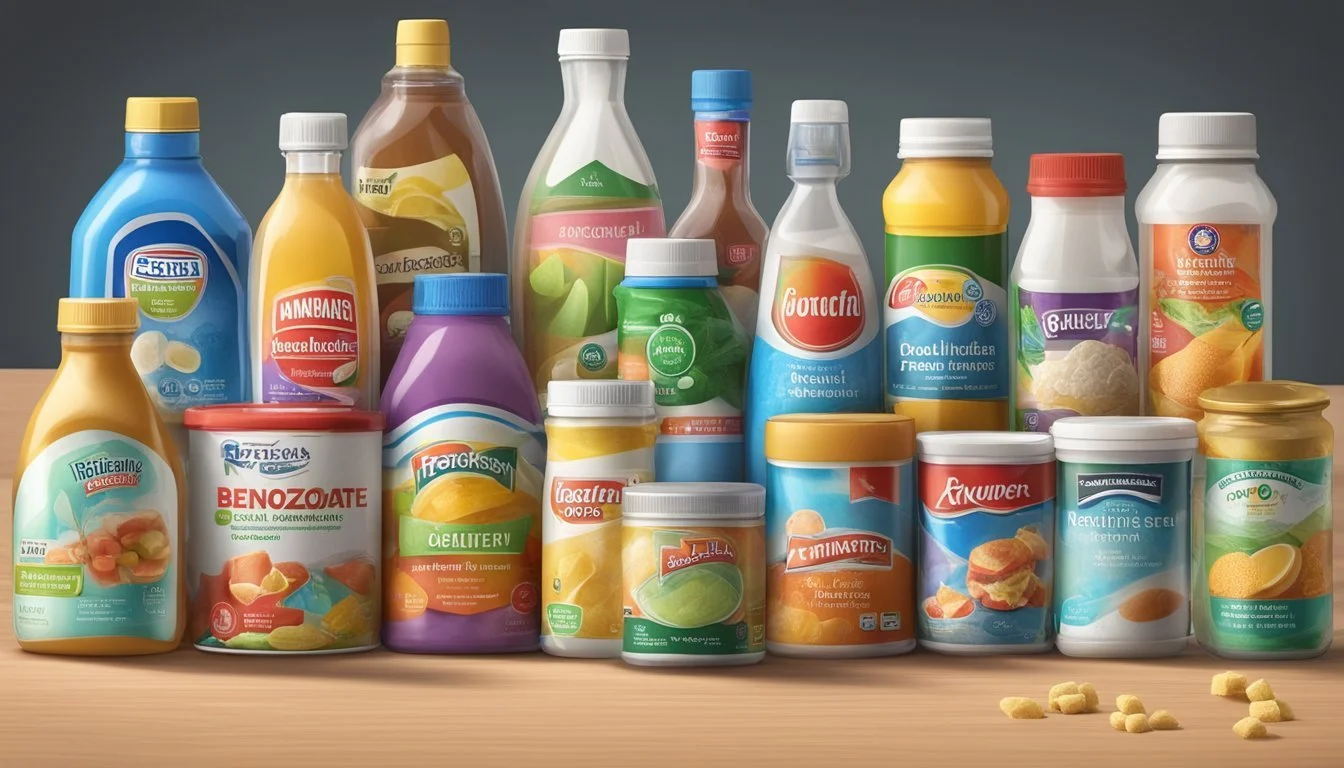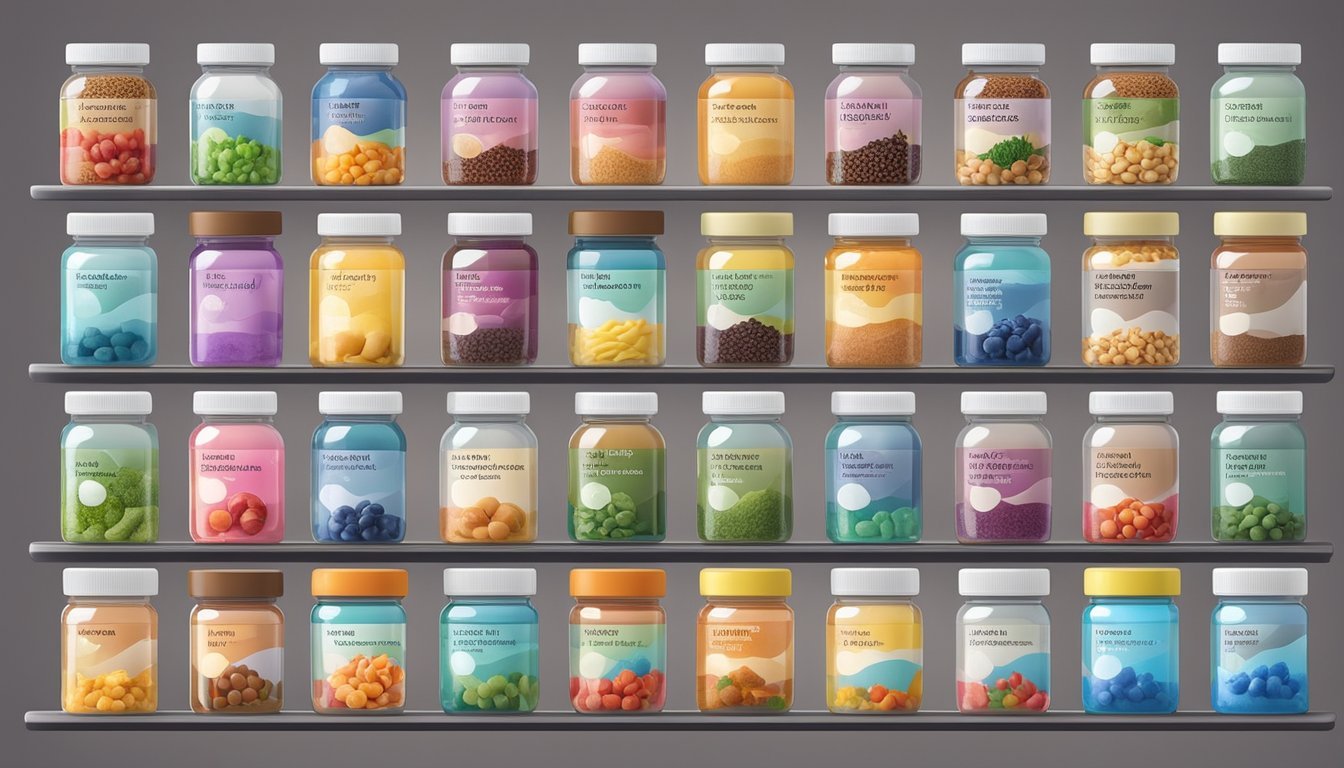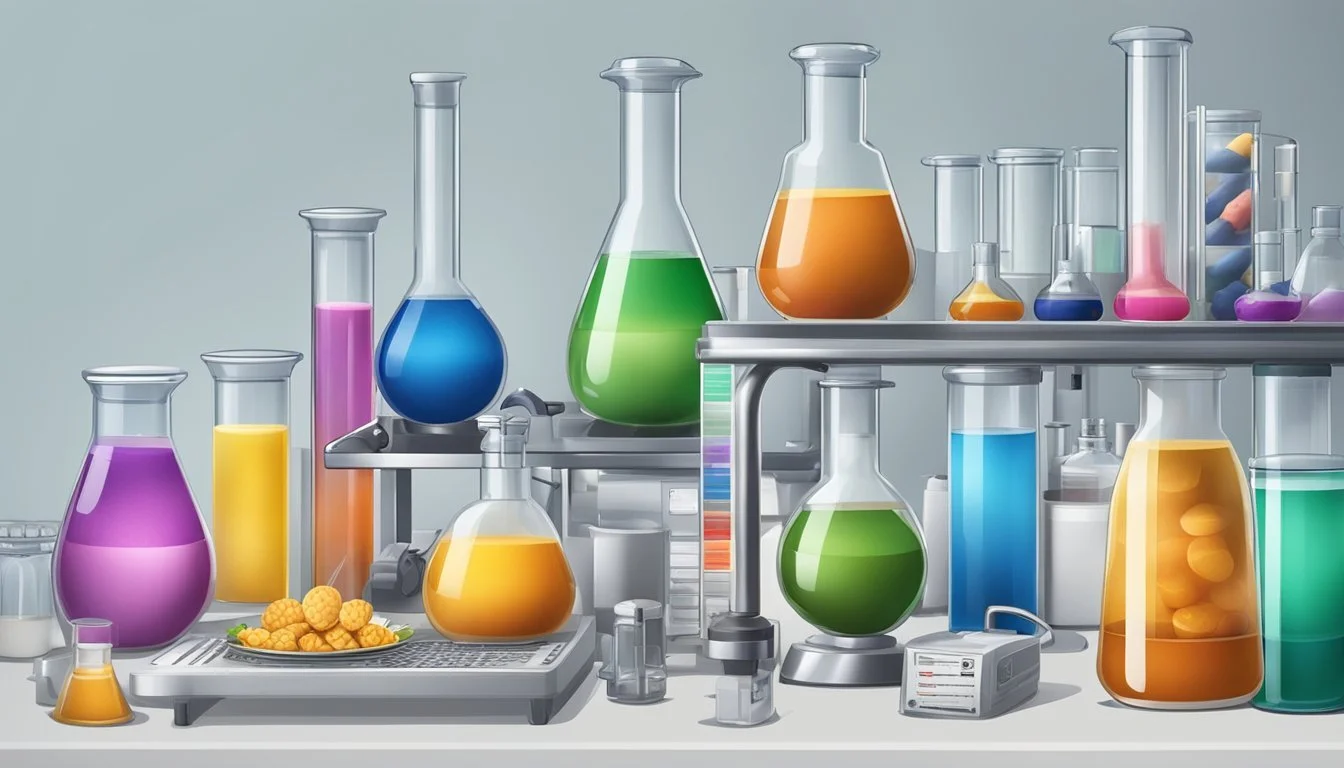10 Food Additives That Aren't As Bad As We Thought
A Reassessment
In modern food production, additives play an essential role in maintaining freshness, enhancing flavors, and improving texture. Many consumers are concerned about the safety of these ingredients, often believing them to be harmful without fully understanding their effects.
Some commonly used food additives, frequently criticized and misunderstood, are actually not as detrimental as we might think. This article explores ten such additives, providing insights into their roles and the current scientific perspective on their safety.
1) Xanthan Gum
Xanthan gum is a widely used food additive known for its properties as a thickener and stabilizer. It is produced by fermenting a carbohydrate with a specific type of bacteria.
Commonly found in products like salad dressings, sauces, and bakery items, xanthan gum helps maintain texture and consistency.
In small amounts, xanthan gum can offer some health benefits, such as lowering blood sugar levels. It also has properties that can help extend the shelf life of food products.
It is safe for most people to consume. However, excessive intake might lead to digestive issues for some individuals. Thus, moderation is key.
Xanthan gum is also utilized in gluten-free and vegan foods, acting as a substitute for gluten in baking. This makes it a valuable additive for those with specific dietary restrictions.
2) Monosodium Glutamate (MSG)
Monosodium Glutamate, often referred to as MSG, is a common flavor enhancer used in many foods. It is the sodium salt of glutamic acid, an amino acid found naturally in various foods.
MSG is included in processed foods such as snacks, canned soups, and frozen meals to enhance their taste. Despite concerns, MSG is safe for most people when consumed in normal quantities.
Research has shown that the body processes MSG the same way it processes naturally occurring glutamate. This means it does not accumulate in the body or cause harm when eaten as part of a balanced diet.
While some people report sensitivity to MSG, these reactions are not widespread. The U.S. Food and Drug Administration (FDA) classifies MSG as "generally recognized as safe" (GRAS).
MSG is also used to reduce sodium levels in foods like sausages, allowing for flavorful products with less salt. This can be beneficial for individuals seeking to lower their sodium intake.
Certain cultural dishes particularly benefit from MSG. For instance, it is used extensively in Asian cuisine to enhance the flavors of soups, sauces, and various dishes, contributing to their savory profile.
Commonly misunderstood, MSG is embedded in food culture worldwide. When included in moderation, it remains a useful additive for enhancing the flavor and nutritional profile of many foods.
3) Aspartame
Aspartame is a widely used artificial sweetener, commonly found in diet sodas and sugar-free products. It was first approved by the U.S. Food and Drug Administration in 1974 for use as a food additive. Its popularity soared in the 1980s when it became a popular ingredient in carbonated beverages.
Many people often express concerns about the safety of aspartame. Extensive research by health organizations, such as the FDA and the European Food Safety Authority, has consistently found aspartame to be safe for consumption within established limits.
A 12-ounce can of diet soda typically contains around 200 milligrams of aspartame. For an adult weighing 150 pounds, the acceptable daily intake equates to roughly 17 cans of diet soda. This is well above what most people consume in a day.
Studies have shown that there are no proven health risks associated with moderate aspartame intake. Despite ongoing debates and some public skepticism, the consensus in the scientific community remains clear on the safety of aspartame when consumed in appropriate amounts.
Aspartame provides a low-calorie alternative to sugar, making it a useful option for those looking to reduce their caloric intake without sacrificing sweetness. This food additive continues to be a common choice for many seeking to manage their weight and sugar intake effectively.
4) Sodium Benzoate
Sodium benzoate is a widely used preservative found in a variety of foods and beverages. Known for preventing the growth of harmful bacteria, it plays a crucial role in extending shelf life.
This additive is commonly present in acidic products, like salad dressings, carbonated drinks, and fruit juices. Despite concerns about its potential to form benzene—a carcinogen—under certain conditions, regulations ensure its safe levels in foods.
Research has shown that sodium benzoate can be quite effective without posing significant health risks when consumed within acceptable limits. Various health authorities have set these limits to ensure consumer safety.
Many scientific studies continue to examine the safety and effectiveness of sodium benzoate. Ongoing research helps refine its usage guidelines, ensuring it remains a valuable tool for food preservation.
5) Calcium Propionate
Calcium propionate is a common food additive. It acts as a preservative, specifically targeting mold and bacterial growth. This makes it especially useful in bakery products where moisture can cause spoilage.
It is the calcium salt of propionic acid. This compound helps extend the shelf life of foods such as breads and meats. By preventing the growth of harmful microorganisms, it allows these items to stay fresh longer.
Many regulatory bodies, including the European Food Safety Authority, have evaluated calcium propionate. Studies generally support its safety for consumption. Thus, its use has become widespread in the food industry.
In addition to its preservative properties, calcium propionate also adds nutritional value. It serves as a source of calcium, contributing to the overall dietary intake of this essential mineral.
6) Carrageenan
Carrageenan is a food additive derived from red seaweed. It is primarily used as a thickening, emulsifying, and stabilizing agent. Many processed dairy products, such as yogurt, ice cream, and coffee creamers, contain carrageenan.
The FDA has approved carrageenan for use in food products. Despite this, some studies suggest that consuming high amounts could lead to inflammation and digestive issues.
Manufacturers rely on carrageenan to improve texture and appearance. It helps keep ingredients from separating in products like liquid infant formula and ready-to-drink protein shakes.
Concerns about carrageenan's safety have led to debates. While some animal studies indicate it may cause gut inflammation, concrete evidence in humans is limited.
Many everyday foods contain carrageenan. Understanding its role can help consumers make informed choices about their diet.
7) Sodium Nitrite
Sodium nitrite is commonly used in the preservation and curing of meats. It helps maintain the color and flavor of the product, making it more appealing to consumers.
There have been concerns about the safety of sodium nitrite due to its potential association with cancer risk when exposed to high temperatures. However, recent studies indicate that moderate consumption within regulated limits poses minimal health risks.
Sodium nitrite also provides effective protection against harmful bacterial growth, particularly Clostridium botulinum, which can cause botulism. This makes it an important additive for food safety in processed meats.
8) Guar Gum
Guar gum is a common food additive derived from guar beans. It's used to thicken and stabilize food products.
One of the primary benefits of guar gum is its ability to form a gel, which helps improve the texture of foods. This makes it a popular ingredient in products such as ice cream, sauces, and gluten-free baked goods.
Research on guar gum indicates that it can have positive health effects when consumed in moderate amounts. It has been shown to reduce blood glucose levels and aid in weight management. This is because guar gum is a type of dietary fiber, which can promote feelings of fullness.
Although there are some concerns about digestive issues when consumed in large quantities, the levels used in food products are typically safe. Guar gum is largely indigestible, which means it passes through the digestive system without breaking down.
As with any food additive, individual reactions can vary. While some people might experience mild digestive discomfort, most individuals can consume guar gum without any adverse effects.
9) Lecithin
Lecithin, a naturally occurring compound, is often derived from sources such as soybeans, eggs, and sunflower seeds. Commercially, soy lecithin is the most common form used in many food products. It serves multiple roles, including acting as an emulsifier, which helps blend ingredients thattypically do not mix well, like oil and water.
Lecithin is also an antioxidant and a flavor protector in foods. These properties help maintain the quality and shelf life of various products. Examples of foods containing lecithin include chocolate, baked goods, and some natural supplements.
There are health benefits associated with lecithin. It is known to aid in liver function, lower cholesterol levels, and enhance cognitive abilities. Some research even suggests that lecithin can help reduce inflammation and improve digestion.
Aside from its health benefits, lecithin is also beneficial in breastfeeding. It can make breastfeeding easier by alleviating issues like clogs in milk ducts. Thus, lecithin has a broad range of applications in both food and health sectors, making it a versatile and valuable additive.
10) Citric Acid
Citric acid is a naturally occurring compound found in various fruits, especially citrus fruits like lemons and limes. It plays a vital role in enhancing the sour taste of foods and beverages.
Apart from its role as a flavor enhancer, citric acid acts as a preservative. This helps in extending the shelf life of canned and packaged goods. Its antioxidant properties contribute to preserving the freshness of food.
In addition to its preservative benefits, citric acid is used as a pH buffer and chelating agent. These properties make it essential in the production of food and beverages. Citric acid ensures that products maintain their texture, taste, and nutritional value.
Concerns about the safety of citric acid often focus on its synthetic production and the potential for contaminants. However, it remains widely regarded as safe for consumption when used within regulatory guidelines.
Understanding Food Additives
Food additives play crucial roles in modern food production, ensuring safety, extending shelf life, and improving sensory properties. It’s essential to grasp what they are and the types available.
Definition and Purpose
Food additives are substances added to foods for various technical reasons. They are not normally consumed as foods themselves and are used primarily to enhance quality and safety.
For example, they may maintain or improve freshness, prevent spoilage, or enhance flavor or appearance. This means they ensure that food lasts longer in storage and remains appealing to consumers. There are strict regulations that control the types of additives that can be used and their permissible quantities, ensuring they are safe for consumption.
Types of Food Additives
Food additives come in several categories, each serving a specific function.
Emulsifiers: Used to mix water and oils, ensuring consistency in products like salad dressings and ice cream.
Preservatives: Help prevent spoilage by inhibiting the growth of microorganisms. Common examples include sodium benzoate and nitrites.
Antioxidants: Protect fats and oils from becoming rancid and prevent the discoloration of foods.
Colorants: Enhance or restore the color of foods to make them more appealing.
Flavor enhancers: Boost the existing flavor of food, with monosodium glutamate (MSG) being a well-known example.
These categories illustrate the diverse roles that additives play in the food industry, making them indispensable in ensuring food quality and safety.
Regulatory Standards and Safety
Ensuring the safety of food additives involves strict regulations and thorough scientific evaluations. These processes guarantee that approved additives are safe for consumption.
Regulations and Guidelines
Food additives in the United States fall under the purview of the Food and Drug Administration (FDA). The FDA's regulatory framework includes the Food Additives Amendment of 1958, which mandates pre-market approval of additives unless they are generally recognized as safe (GRAS).
GRAS additives are those commonly recognized through scientific consensus or historical use. The 2016 revision to GRAS policy introduced more rigorous safety assessments and transparency requirements to maintain public trust in their safety.
Internationally, agencies such as the European Food Safety Authority (EFSA) and Codex Alimentarius Commission establish guidelines that harmonize standards across different countries. The Codex General Standard for Food Additives (GSFA) sets maximum levels for additives in various food categories, ensuring consistency and safety across borders.
Scientific Evaluation
Food additives undergo comprehensive scientific evaluations assessing their potential health effects. These evaluations consider toxicological data, including acute and chronic toxicity studies, carcinogenicity, reproductive toxicity, and developmental toxicity.
Scientific bodies, such as the Joint FAO/WHO Expert Committee on Food Additives (JECFA), perform risk assessments based on available data. JECFA's assessments aid in establishing acceptable daily intakes (ADIs), which determine safe consumption levels over a lifetime without adverse health effects.
To address public concerns, ongoing research and post-market surveillance are conducted even after approval. Reevaluations ensure that new scientific evidence is taken into account, reflecting the latest understanding of additive safety. This rigorous process helps protect consumer health and upholds the integrity of food safety standards.
Common Misconceptions About Food Additives
Food additives often carry a negative reputation, but this perception can be misleading. Many common beliefs about these substances stem from misunderstandings or outdated information.
Misconception 1: All additives are harmful chemicals.
Additives must pass rigorous safety assessments before approval. This includes toxicology tests and dietary exposure evaluations. These reviews ensure that additives like soy lecithin, an emulsifier and antioxidant, do not pose significant health risks.
Misconception 2: Additives cause cancer.
Concerns about additives linked to cancer often arise from studies on rodents or cells. However, real-world dietary exposures differ significantly from lab conditions. Reputable organizations like the FDA provide guidelines based on comprehensive scientific data.
Misconception 3: Natural foods are always additive-free.
Even "natural" or minimally processed foods can contain additives. For instance, citric acid maintains freshness in a variety of fruit products. It’s important to recognize that some natural additives play essential roles in food safety and quality.
Misconception 4: Additives are unnecessary and only benefit manufacturers.
Additives enhance food safety, shelf life, and nutritional value. Sodium nitrite, for example, prevents bacterial growth in meats. Without such additives, the risk of foodborne illnesses would increase.
Misconception 5: Additives are a modern problem.
Historically, humans have used additives like salt and vinegar for preservation and flavoring. The difference today is the broader range and stricter regulations governing their use.
Misconception 6: Additives contribute to obesity and heart disease.
While overconsumption of ultra-processed foods is linked to health issues, it's crucial to differentiate between food additives and overall diet quality. Moderation and balance are key.










